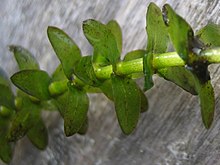Elodea
| Elodea | |
|---|---|

| |
| Elodea canadensis foliage detail | |
| Scientific classification | |
| Kingdom: | Plantae |
| Clade: | Tracheophytes |
| Clade: | Angiosperms |
| Clade: | Monocots |
| Order: | Alismatales |
| Family: | Hydrocharitaceae |
| Subfamily: | Anacharioideae |
| Genus: | Elodea Michx., 1803 |
| Synonyms[1] | |
Elodea is a genus of eight species of aquatic plants often called the waterweeds described as a genus in 1803. Classified in the frog's-bit family (Hydrocharitaceae), Elodea is native to the Americas[1] and is also widely used as aquarium vegetation and laboratory demonstrations of cellular activities. It lives in fresh water.[2] An older name for this genus is Anacharis, which serves as a common name in North America.[3]
The introduction of some species of Elodea into waterways in parts of Europe, Australia, Africa, Asia, and New Zealand has created a significant problem and it is now considered a noxious weed in these areas.
- Species[1]
- Elodea bifoliata H.St.John – Canada (AB, SK), W United States (OR + CA to NM + MN)
- Elodea callitrichoides (Rich.) Casp. – Argentina, Uruguay
- Elodea canadensis Michx. – most of United States + Canada
- Elodea densa (Planch.) Casp.
- Elodea granatensis Bonpl. – much of South America
- Elodea heterostemon (S.Koehler & C.P.Bove) Byng & Christenh.
- Elodea najas (Planch.) Casp.
- Elodea nuttallii (Planch.) H.St.John – much of United States + Canada
- Elodea potamogeton (Bertero) Espinosa – Chile, Peru, Bolivia, Ecuador
Chemical control
[edit]Chemical methods are ineffective in eradicating Elodea – at best they only slow growth for a season or two.[4] As Elodea spreads into new ecosystems, it experiences rapid growth for 5–6 years and then slows as soil nutrients are used up.[5] Elodea is threatening aquatic environments across Europe.[6] Chemicals may be used in places that cause undue economic concerns, but very few aquatic herbicides are registered for aquatic use in the EU. Fluridone, the most commonly used aquatic herbicide is highly effective against Hydrilla, but only marginally effective against Elodea, especially at lower use rates.[7][8][9]
Mechanical control
[edit]
The plants can also be removed from lakes and rivers mechanically. They are extracted either by hand or by using rakes, chains, mowing boats or weed buckets. The problem is that through vegetative reproduction via fragments, mechanical removal methods can contribute to the spread of the plant. Torn fragments can be transported downstream or are introduced to new environments via attachment to boats and anchor chains.[10]
See also
[edit]- Stormy Lake (Alaska) a lake where Fluoridone was successfully used to eliminate elodea
- Grass carp also effective against elodea
References
[edit]- ^ a b c "Elodea Michx". Plants of the World Online. Royal Botanic Gardens, Kew. Retrieved 13 October 2024.
- ^ Luteyn, J. L. 1999. Páramos, a checklist of plant diversity, geographical distribution, and botanical literature. Memoirs of The New York Botanical Garden 84: viii–xv, 1–278
- ^ "Elodea in Flora of North America @ efloras.org". www.efloras.org. Retrieved 2017-01-31.
- ^ "Efficacy of Fluridone, Penoxsulam, and Bispyribac-sodium on Variable-leaf Milfoil". ResearchGate. Retrieved 2015-08-26.
- ^ Thiébaut, Gabrielle (2005-09-01). "Does competition for phosphate supply explain the invasion pattern of Elodea species?". Water Research. 39 (14): 3385–3393. Bibcode:2005WatRe..39.3385T. doi:10.1016/j.watres.2005.05.036. ISSN 0043-1354. PMID 16026814.
- ^ Lambertini, Carla; Riis, Tenna; Olesen, Birgit; Clayton, John S; Sorrell, Brian K; Brix, Hans (2010-06-18). "Genetic diversity in three invasive clonal aquatic species in New Zealand". BMC Genetics. 11: 52. doi:10.1186/1471-2156-11-52. ISSN 1471-2156. PMC 2902404. PMID 20565861.
- ^ Arias, Renée S.; Netherland, Michael D.; Scheffler, Brian E.; Puri, Atul; Dayan, Franck E. (2005-03-01). "Molecular evolution of herbicide resistance to phytoene desaturase inhibitors in Hydrilla verticillata and its potential use to generate herbicide-resistant crops". Pest Management Science. 61 (3): 258–268. doi:10.1002/ps.1022. ISSN 1526-498X. PMID 15668922. S2CID 23469042.
- ^ Michel, Albrecht; Arias, Renee S.; Scheffler, Brian E.; Duke, Stephen O.; Netherland, Michael; Dayan, Franck E. (2004-10-01). "Somatic mutation-mediated evolution of herbicide resistance in the nonindigenous invasive plant hydrilla (Hydrilla verticillata)". Molecular Ecology. 13 (10): 3229–3237. Bibcode:2004MolEc..13.3229M. doi:10.1111/j.1365-294X.2004.02280.x. ISSN 0962-1083. PMID 15367135. S2CID 19191358.[permanent dead link]
- ^ Sepro, Corp. "SONAR H4C Label" (PDF). Sonar H4C Aquatic Herbicide. Sepro.
- ^ "GISD".
External links
[edit] Media related to Elodea at Wikimedia Commons
Media related to Elodea at Wikimedia Commons- Jepson Manual Treatment
